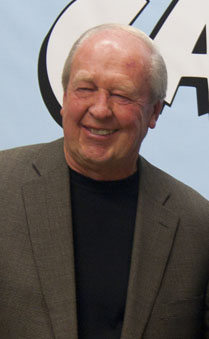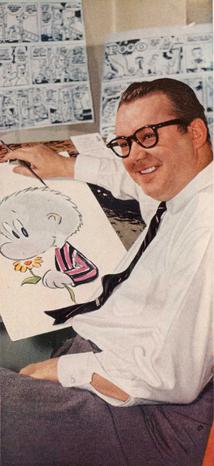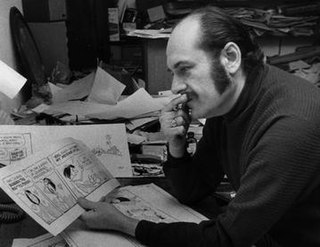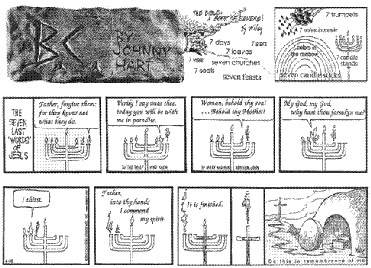A comic strip is a sequence of cartoons, arranged in interrelated panels to display brief humor or form a narrative, often serialized, with text in balloons and captions. Traditionally, throughout the 20th and into the 21st century, these have been published in newspapers and magazines, with daily horizontal strips printed in black-and-white in newspapers, while Sunday papers offered longer sequences in special color comics sections. With the advent of the internet, online comic strips began to appear as webcomics.

A cartoon is a type of visual art that is typically drawn, frequently animated, in an unrealistic or semi-realistic style. The specific meaning has evolved, but the modern usage usually refers to either: an image or series of images intended for satire, caricature, or humor; or a motion picture that relies on a sequence of illustrations for its animation. Someone who creates cartoons in the first sense is called a cartoonist, and in the second sense they are usually called an animator.

The Wizard of Id is a daily newspaper comic strip created by American cartoonists Brant Parker and Johnny Hart. Beginning November 16, 1964, the strip follows the antics of a large cast of characters in a shabby medieval kingdom called "Id". The title is a play on The Wizard of Oz, combined with the Freudian psychological term id, which represents the instinctive and primal part of the human psyche.

James Robert Davis is an American cartoonist, screenwriter, and producer. He is best known as the creator of the comic strips Garfield and U.S. Acres. Published since 1978, Garfield is one of the world's most widely syndicated comic strips. Davis's other comics work includes Tumbleweeds, Gnorm Gnat, and Mr. Potato Head.

The Far Side is a single-panel comic created by Gary Larson and syndicated by Chronicle Features and then Universal Press Syndicate, which ran from December 31, 1979, to January 1, 1995. Its surrealistic humor is often based on uncomfortable social situations, improbable events, an anthropomorphic view of the world, logical fallacies, impending bizarre disasters, references to proverbs, or the search for meaning in life. Larson's frequent use of animals and nature in the comic is popularly attributed to his background in biology. The Far Side was ultimately carried by more than 1,900 daily newspapers, translated into 17 languages, and collected into calendars, greeting cards, and 23 compilation books, and reruns are still carried in many newspapers. After a 25-year hiatus, in July 2020 Larson began drawing new Far Side strips offered through the comic's official website.

Walter Crawford Kelly Jr., commonly known as Walt Kelly, was an American animator and cartoonist, best known for the comic strip Pogo. He began his animation career in 1936 at Walt Disney Studios, contributing to Pinocchio, Fantasia, and Dumbo. In 1941, at the age of 28, Kelly transferred to work at Dell Comics, where he created Pogo, which eventually became his platform for political and philosophical commentary.
Thor, the god of Norse mythology, has appeared as a character in various comics over the years, appearing in series from a range of publishers.

John Lewis Hart was an American cartoonist noted as the creator of the comic strips B.C. and The Wizard of Id. Brant Parker co-produced and illustrated The Wizard of Id. Hart was recognized with several awards, including the Swedish Adamson Award and five from the National Cartoonists Society. In his later years, he was known for incorporating Christian themes and messages into his strips. Hart was referred to by Chuck Colson in a Breakpoint column as "the most widely read Christian of our time," over C. S. Lewis, Frank E. Peretti, and Billy Graham.

King Features Syndicate, Inc. is an American content distribution and animation studio, consumer product licensing and print syndication company owned by Hearst Communications that distributes about 150 comic strips, newspaper columns, editorial cartoons, puzzles, and games to nearly 5,000 newspapers worldwide. King Features Syndicate also produces intellectual properties, develops new content and franchises, like The Cuphead Show!, which it produced with Netflix, and licenses its classic characters and properties.

Non Sequitur is a comic strip created by Wiley Miller starting February 16, 1992 and syndicated by Andrews McMeel Syndication to over 700 newspapers. It is also published on gocomics.com and distributed via email.

The B.C. Icemen were an ice hockey team in the United Hockey League (UHL). They played in Binghamton, New York, at the Broome County Veterans Memorial Arena.

Thomas Martin Batiuk is an American comic strip creator, best known for his long-running newspaper strip Funky Winkerbean.
Jimmy Johnson is an American comic strip cartoonist who writes and draws Arlo and Janis.

Tor is an American comic book series, created by Joe Kubert and Norman Maurer in the story 1,000,000 Years Ago!, published by St. John Publications. The series' protagonist, Tor, is a prehistoric cave man who has fantasy adventures set in a realistically drawn setting. The original series only ran for five issues and ended in 1954. Tor was revived by DC Comics in June 1975 for six issues. In June 1993, Marvel Comics released new adventures of Tor.

Henry Boltinoff was an American cartoonist who worked for both comic strips and comic books. He was a prolific cartoonist and drew many of the humor and filler strips that appeared in National Periodical comics from the 1940s through the 1960s.

Howard "Howie" Post was an American animator, cartoonist, and comic strip and comic book writer-artist.

Richard S. Newcombe is the founder and chairman of Creators Syndicate, which currently represents more than 200 writers and artists and has expanded to include Creators Publishing. Since the company's founding in 1987, the roster of talent has included Ann Landers, Hillary Clinton, Bill O'Reilly, Hunter S. Thompson, Herblock and the comic strips B.C., The Wizard of Id, Archie and Mickey Mouse. Creators Syndicate is located in Hermosa Beach, California, and distributes its content to 2,400 newspapers, magazines, websites and other digital outlets around the world.
Mason Mastroianni is an American comic artist and the grandson of Johnny Hart, creator of the comic strips B.C. and Wizard of Id.
Elmer Woggon, who signed his art Wog, was the creator of an early newspaper comic strip that eventually developed into the long-running Steve Roper and Mike Nomad.
A zombie strip is a comic strip whose creator has died or retired, but which continues to exist with new installments in syndication done by a succeeding writer or artist, most often relatives of the original creator. Zombie comic strips are often criticized as lacking the "spark" that had originally made the strip successful.















